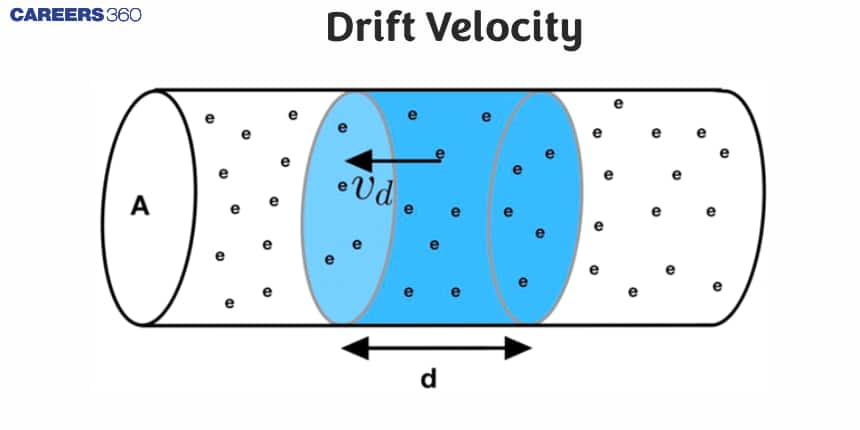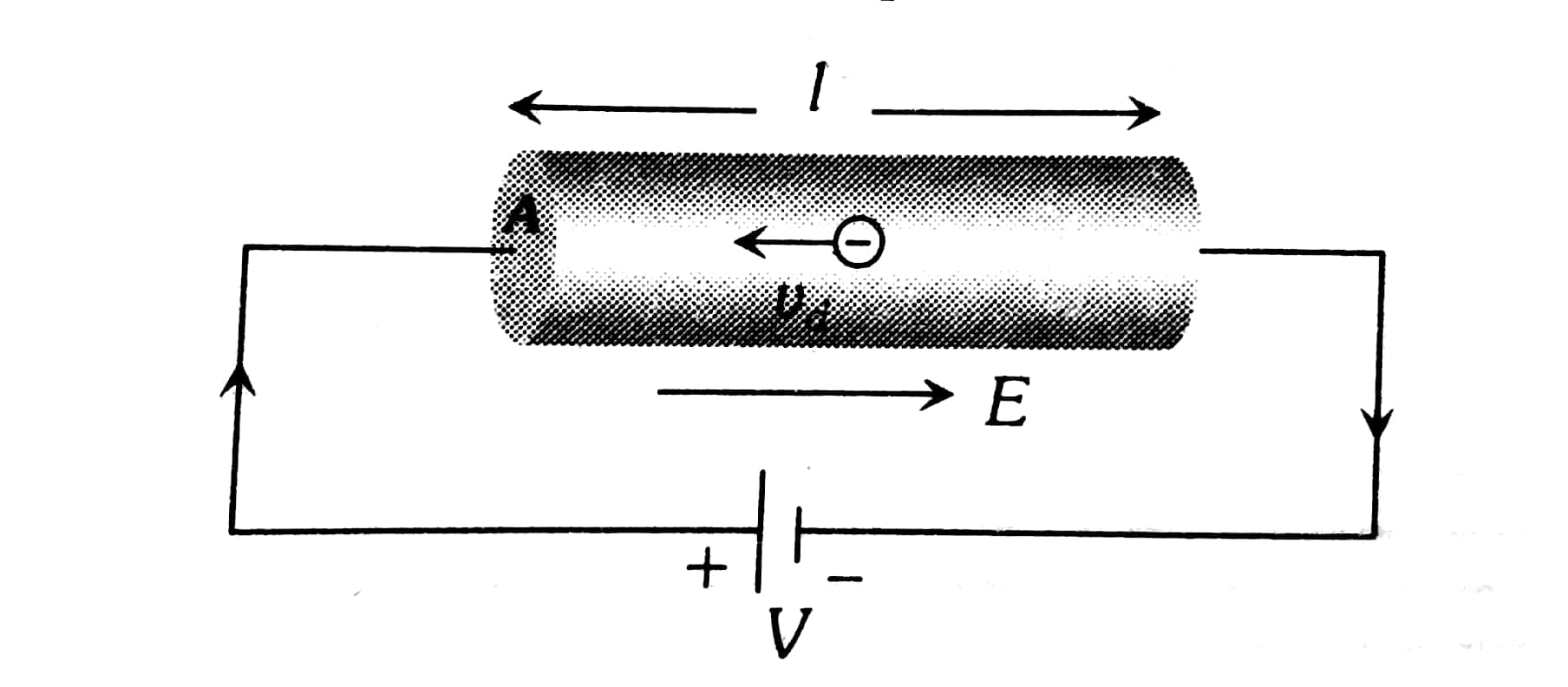Drift Velocity - Meaning, Formula, FAQs
The free electrons in a conductor are always in a continuous random motion due to the thermal energy of the conductor and the average speed at which free electrons 'drift' in the presence of an electric field is called drift velocity. In this article, we will discuss what is drift velocity, the drift velocity formula, the relation between current density and drift velocity, the relation between drift velocity and electric current, and factors affecting drift velocity. Over the last ten years of the JEE Main exam (from 2013 to 2023), nine questions have been asked on this concept.
This Story also Contains
- What is Drift Velocity Class 12?
- Drift Velocity Formula Class 12
- Relation Between Current Density and Drift Velocity
- Relation Between Drift Velocity and Electric Current
- Factors Affecting Drift Velocity
- Important Terms Related to Drift Velocity
- Solved Examples Based on Drift Velocity

What is Drift Velocity Class 12?
Drift velocity definition: Drift velocity is the average velocity that a particle such as an electron attains in a material due to an electric field.
Drift velocity definition in terms of an electron: The drift velocity of an electron in a conductor is the average velocity an electron acquires in the presence of an electric field.
Drift Velocity Formula Class 12
$$V_d=\frac{I}{n A e}$$
where,
- $V_d$ is the drift velocity of the electrons
- $I$ is the electric current flowing through the conductor
- $n$ is the number density of free electrons
- $A$ is the cross-sectional area of the conductor
- $e$ is the charge of an electron
Drift velocity in terms of electric field ($E$) and mobility of electrons ($\mu$)
$$
V_d=\mu E
$$
$V_d$ is directly proportional to $E$:
$V_d \propto E$ when the temperature is constant, the greater the electric field, the larger the drift velocity.
Drift velocity varies inversely with the area of the cross-section

Also, read
- NCERT Solutions for All Subjects
- NCERT Notes for all subject
- NCERT Exemplar Solutions for All Subjects
SI Unit of Drift Velocity
The SI unit of drift velocity is meters per second ( $\mathrm{m} / \mathrm{s}$ ).
$V_d=\frac{I}{n A e}$
substituting unit of each term
$V_d=\frac{\mathrm{A}}{\left(\mathrm{m}^{-3}\right)\left(\mathrm{m}^2\right) \mathrm{C}}$
$V_d=\frac{\mathrm{A}}{\mathrm{m}^{-1} \cdot \mathrm{C}}$
$V_d=\frac{\mathrm{C} / \mathrm{s}}{\mathrm{m}^{-1} \cdot \mathrm{C}}$
Thus simplifying we get
$$V_d=\frac{\mathrm{m}}{\mathrm{s}}$$
Relation Between Current Density and Drift Velocity
The drift velocity is directly proportional to the current density.
$$
J=n e V_d
$$
where,
$J$ is the Current Density
$n$ is the number density of electrons in a conductor
$e:$ is the charge of an electron
$V_d$ is the drift velocity
Relation Between Drift Velocity and Electric Current
The drift velocity is directly proportional to the electric current.
$$
I=n A e v_d
$$
hence,
$$
I \propto v_d
$$
Factors Affecting Drift Velocity
- Electric field
- Charge of the electron
- The number density of electrons
- Temperature
- Mobility of electron
Important Terms Related to Drift Velocity
-
Relaxation Time (τ):
The time interval between two successive collisions of electrons with the Positive ions.
-
Mean Free Path:
The path between two consecutive collisions is called the free path. The average length of these free paths is called the “Mean Free Path”.
-
Mobility Of An Electron:
It is the drift velocity of an electron per unit electric field. It indicates how easily an electron can pass through the material (conductor or semiconductor) in the presence of an electric field.
$$\mu=\frac{v_d}{E}$$
|
Related Topics, |
Recommended Topic Video
Solved Examples Based on Drift Velocity
Example 1: Drift speed of electrons, when 1.5 A of current flows in a copper wire of cross-section is v . If the electron density in copper is $9 \times 1028 / \mathrm{m} 3$ the value of $v$ in $\mathrm{mm} / \mathrm{s}$ is close to (Take charge of an electron to be $=1.6 \times 10-19 \mathrm{C}$ )
1) 0.02
2) 3
3) 2
4) 0.2
Solution:
$\begin{gathered}I=n e A V_d \\ V_d=\frac{I}{n e A}=\frac{9 \times 10^{28} \times 1.6 \times 10^{-19} \times 5 \times 10^{-6}}{1}=0.02 \times 10^{-3} \mathrm{~m} / \mathrm{s}=0.02 \mathrm{~mm} / \mathrm{sec}\end{gathered}$
Hence, the answer is the option (1).
Example 2: A current of 10 A exists in a wire of a cross-sectional area of 5 mm 2 with a drift velocity of $2 \times 10-3 \mathrm{~ms}-1$. The number of free electrons in each cubic meter of the wire is:
1) 1×1023
2) 625×1025
3) 2×1025
4) 2×106
Solution:
\begin{aligned}
&i=10 \mathrm{~A}, A=5 \mathrm{~mm}^2=5 \times 10^{-6} \mathrm{~m}^2 \text { and } v_d=2 \times 10^{-3} \mathrm{~m} / \mathrm{s}\\
&\text { We know, }\\
&\begin{gathered}
i=n e A v_d \\
10=n \times 1.6 \times 10^{-19} \times 5 \times 10^{-6} \times 2 \times 10^{-3} \Rightarrow n=0.625 \times 10^{28}=625 \times 10^{25}
\end{gathered}
\end{aligned}
Hence, the answer is the Option(2).
Example 3: When a 5 V potential difference is applied across a wire of length 0.1 m, the drift speed of electrons is $2.5 \times 10^{-4} \mathrm{~ms}^{-1}$. If the electron density in the wire is $8 \times 10^{28} \mathrm{~m}^{-3}$, the resistivity of the material is close to:
1) $1.6 \times 10-8 \Omega \mathrm{~m}$
2) $1.6 \times 10-7 \Omega \mathrm{~m}$
3) $1.6 \times 10-6 \Omega \mathrm{~m}$
4) $1.6 \times 10-5 \Omega \mathrm{~m}$
Solution:
\begin{aligned}
& I=A n e v_{-} d \\
& \Rightarrow V=R A n e v_{-} d \\
& \Rightarrow V(\rho I / A)=A n e v_{-} d \\
& \Rightarrow V A / \rho I=A n e v_{-} d \\
& \Rightarrow \rho=V / I^*\left(1 / n v_{-} d\right) \\
& \Rightarrow \rho=V I /\left(n e v_{-} d\right) \\
& =50.1 \times\left(8 \times 10^{\wedge} 28\right) \times\left(1.6 \times 10^{\wedge}(-19)\right) \times\left(2.5 \times 10^{\wedge}(-4)\right) \\
& \Rightarrow \rho=1.5625 \times 10^{\wedge}(-5) \Omega \mathrm{m} \approx 1.6 \times 10^{\wedge}(-5) \Omega \mathrm{m}
\end{aligned}
Hence, the answer is the option (4).
Example 4: An electron moving in a zigzag path travels a displaces by 0.2 mm in 10 seconds. Its drift speed is (in $\mathrm{m} / \mathrm{sec}$ )
1) $2 \times 10^{-5}$
2) $10^{-5}$
3) $2 \times 10^{-4}$
4) $10^{-4}$
Solution:
Drift velocity
Drift velocity is the average velocity that a particle such as an electron attains in a material due to an electric field.
wherein

Drift Velocity = Displacement/time
Displacement $=.2 \mathrm{~mm}=2 \times 10^{-4} \mathrm{~m}$
Time = 10 sec
Drift Velocity $V_d=2 \times 10^{-5} \mathrm{~m} / \mathrm{sec}$
Hence, the answer is option (1).
Example 5: Which of the following is correct regarding relaxation time?
1) Relaxation time increases with increase in temperature
2) Relaxation time decreases with increase in temperature
3) A decrease in relaxation time causes a decrease in resistivity
4) Conductivity is independent of Relaxation time
Solution:
Relaxation time ($\tau$)⟶ The time interval between two successive collisions of electrons with the ions/ atoms.
As with an increase in temperature drift velocity increases which will lead to an increase in the rate of collision and hence relaxation time decreases.
Hence, the answer is the option (2).
Frequently Asked Questions (FAQs)
The ease with which a specific type of charged particle moves through a material under the influence of an electric field is referred to as mobility in physics. Electric fields attract these particles, which interact with solid molecules on a regular basis. The average speed at which the particles travel as a result of the electric field and collision is known as drift speed. In most metals, the charge carrier is a negatively charged electron.
Electron mobility is used to determine how rapidly an electron moves through a metal or semiconductor under the influence of an electric field.
Electron mobility is expressed mathematically as: μ=VdE .
Where vd is the electron's drift velocity and E is the external electric field.
The Si unit of mobility is the m2v-1s-1.
Any conductor's drift velocity is independent of its cross-sectional area or diameter..
The average velocity that an electron achieves as a result of an electric field is known as the electron drift velocity. The average velocity, or electron drift velocity, is very low due to collisions between electrons.
The electric current produced by particles being dragged by an electric field is known as drift current. Although the phrase is most usually associated with electrons and holes in semiconductors, the concept can also be applied to metals, electrolytes, and other materials.